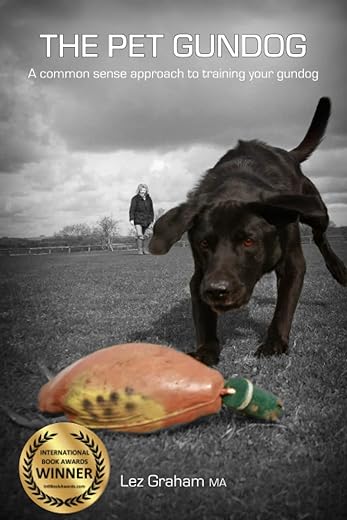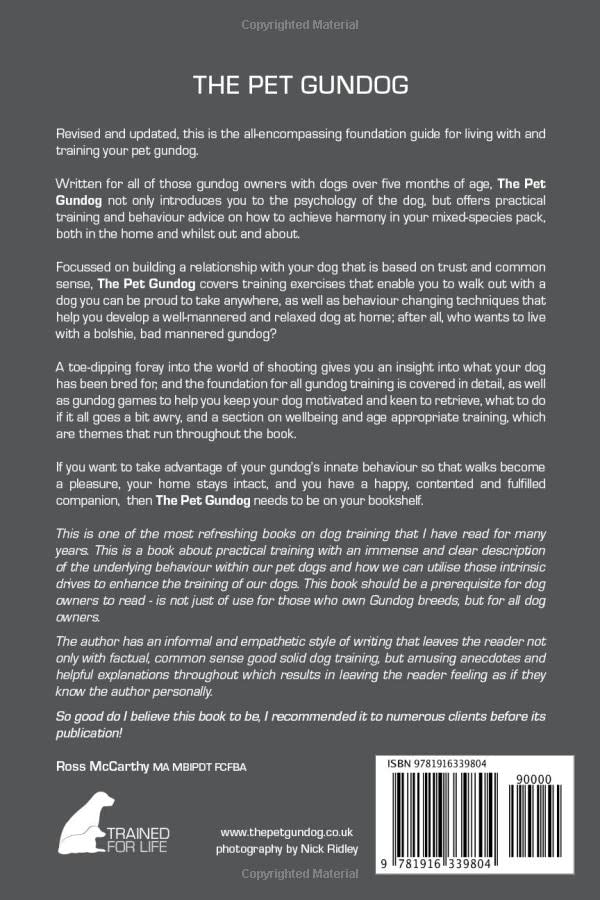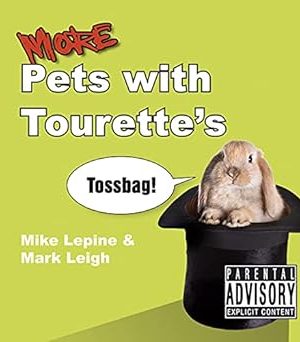The Pet Gundog: A common sense approach to training your gundog
£18.30£19.00 (-4%)
The Pet Gundog
(Please note: The sequence of books is The Pet Gundog Puppy OR The Pet Gundog, followed by The Advanced Pet Gundog.)
Revised and updated, this is the all-encompassing foundation guide for living with and training your gundog.
Written for all of those gundog owners with dogs over five months of age, The Pet Gundog not only introduces you to the psychology of the dog, but offers practical training and behaviour advice on how to achieve harmony in your mixed – species pack, both in the home and whilst out and about.
Focussed on building a relationship with your dog that is based on trust and common sense, The Pet Gundog covers training exercises that enable you to walk out with a dog you can be proud to take anywhere, as well as behaviour changing techniques that help you develop a well-mannered and relaxed dog at home; after all, who wants to live with a bolshie, bad mannered gundog?
A toe-dipping foray into the world of shooting gives you an insight into what your dog has been bred for, and the foundation for all gundog training is covered in detail, as well as…
- Optimum health and wellbeing
- Socialisation for the adult dog
- Age appropriate training
- Foundation training
- Upping the Ante for the novice pet gundog
- Bringing home a part – trained or rescue gundog
- Gundog games
- Training challenges
If you want to take advantage of your gundog’s innate behaviour so that walks become a pleasure, your home stays intact and you have a happy, contented and fulfilled companion, then The Pet Gundog needs to be on your bookshelf.
Author’s note :
If your puppy hasn’t reached the adolescent stage, and by that I mean he’s under four and a half months old, then do yourself a favour and go for The Pet Gundog Puppy rather than this book as The Pet Gundog has been written with dogs over 5 months in mind.
Read more
Additional information
| Publisher | 3rd edition (4 May 2020), Braidwood Books |
|---|---|
| Language | English |
| Paperback | 196 pages |
| ISBN-10 | 1916339808 |
| ISBN-13 | 978-1916339804 |
| Dimensions | 15.24 x 1.19 x 22.86 cm |








by Customer review
Had looked forward to adding “The Pet Gundog” to my expanding dog training library, however the content is so disappointing.
If I was looking for a book that reinforced the ego-centric ideas from a generation ago, I would have probably been delighted.
The training drills towards the end may be useful, but I would be reluctant to pass this book on due to the outdated advice it is promoting.
Anyone who has read anthrozoologist Dr John Bradshaw’s work “In Defence of Dogs” or Barry Eaton’s little book “Dominance in Dogs: Fact or Fiction”, which robustly debunk the many pack/hierarchy/dominance/wolf theories, will be more than surprised to read the author continue to perpetuate some of these myths and use them as rationale for some of the training methods.
Curious readers may like to compare the author’s discussion on kennel versus house dogs with Karen Pryor’s observations in chapter 4 of the ground breaking book “Don’t Shoot the Dog” on motivation through deprivation.
The chapter on “Motivators” misses an enormous amount of understanding now available on how the canine brain works, and how behaviour is driven – the author continues with outdated “pack” theory. A reader may like to compare the discussion with that of Jane Arden’s “building reward systems” in her book “Mission Control”.
The author appears to be dismissive of teaching a dog ready for a shoot through clicker training or working for food.
This is the attitude of many in the shooting world who still see the skill as a craft, handed down over generations, rather than using techniques in response to scientific understanding of canine brain function.
They can be forgiven for this, the introduction of these techniques are fairly recent; there are fewer highly skilled trainers around who are able to demonstrate what performance is really like after the many hours of practice.
Most sceptics will have only met the novice.
Passing judgement would be like commenting on the violin as an instrument after only attending primary school violin concerts!
The curious or sceptic may wish to follow skilled individuals such as field trial judge Sally Richardson of Wedgnock dogs or field champion trainer and judge Laura Hill of Stautonvale dogs, who has also recently released a book “Advanced Retriever Training”, to get a true picture of what this style of training looks like when it is done well.
On page 39 the author describes a technique to confront a labrador who has started to growl.
This is deeply troubling on two counts. Both the animal’s behaviour and the authors response are mild, but it demonstrates a clear lack of current understanding of canine behaviour and appropriate management. It is now said that suppressing the growl is like taking the battery out of a smoke detector! Second, the book is aimed at a novice audience, who will not have intuition gained from experience on their side to recognise ,as to when, this really is a dangerous approach.
The instructions for training of behaviours such as walking to heel and sit, many would view as dated and focus entirely on achieving a goal behaviour without any consideration of what is going on for the dog in the moment.
A well informed instructor would be helping the novice focus on the environment of the request, and how that has an impact on the animals arousal fear/euphoria state and its ability to respond to the cue in that environment, and also how the handler is delivering the cue request- handler’s own body shape etc . The reader may like to compare advice with authors such as Jane Arden and also Leanne Smith’s “ Whose walk is it anyway” or Jo Lauren’s “ Force -Free Gundog training”
On page 105, I would be concerned for the novice with limited understanding of animal body language if they have an animal who doesn’t manage stress levels well, using the authors “leave” technique which involves tapping the animal’s nose if it tries to take the food from the hand.
If you are considering buying the book, you may be interested to also pick up along with this a copy of Jean Donaldson’s “Culture Clash” or B Hare and V Wood’s “The Genius of Dogs” to give you a well-rounded perspective ,so that you can make a really well informed choice about how you want to train your dog in the long term.
If you are new to dog training and want an easy bedtime read,introducing current understanding in canine behaviour then Sarah Whitehead’s case studies in“Clever Dog “ is a good place to start. For those who prefer to listen rather than read, all three above are available as an audio book.
by BeverleyYoung
Very clear, well written.
Even works with pointers!
by lottie
I can’t recommend this book and training approach highly enough. Following this has made such a difference to our cocker spaniel pup, wish I’d found it earlier! It has also really helped us understand how our dog thinks, how our actions translate into canine and most importantly changed how we think and act. The naughty dog behaviour is a lot less frustrating now we understand it more and when it is (more often than we realised!) our fault!
The online videos are really helpful as is the Facebook page.
by mrs j quaile
Well written with some handy tips
by Mrs L M Arthur
This book has been a godsend! Lez uses plain straight talking to get her message across and you instantly feel as if she knows you and your dog. She explains her techniques simply yet in great detail and with the aid of short online videos. I found confidence in the fact that she is highly qualified in her field as I grow increasingly wary of an industry that remains unregulated.
I finally came to this book after spending the first 6 months with my Gundog-breed pup training the new fun, lively, constant treat-based method that bombards our social media every day. I’ve had dogs for 26 years but thought perhaps new methods might be worth a go, especially since lockdown presented barriers to face to face training. I ended up with a young adult dog wound like a spring with little control. I have never regretted anything more.
There has been a huge and almost immediate change in my dog’s attitude towards myself and we are gradually undoing the harm done but it would have been a much easier journey had I found Lez Graham sooner.
And yes, this training is still based on positive reinforcement and we are still having fun, but on my terms now and in a much more controlled manner and with a far happier and more contented dog.
by BeverleyYoung
The Pet Gun Dog, really enjoying this book it is so informative and helpful as I train my 11 mth black lab. Thank you to Swiftdogtraininguk dog training for the introduction and to Lez Graham for such a fantastic resource,
by Trish
This book is absolutely packed with both general and specific information about understanding, nurturing and training your dog. Many of the topics covered apply to all dogs, building the partnership so vital to enjoying a rewarding life together. Whilst particular chapters are aimed at teaching and enabling gundogs to do what they are born to do – really the point of the book. The author writes as she speaks, easy to read and remember, based on long and broad experience of dogs in general, but particularly gundogs. Buying the book provides an added bonus in providing access to video clips demonstrating the techniques described in the book. I have found it invaluable, every page full of useful information, clearly set out and easy to understand with no wasted waffle.
by Shawn
A friend suggested I get this book, having recently gotten an HPR, and it has proven to be really helped! Full of useful insights into what makes a gundog tick and how to go training one.